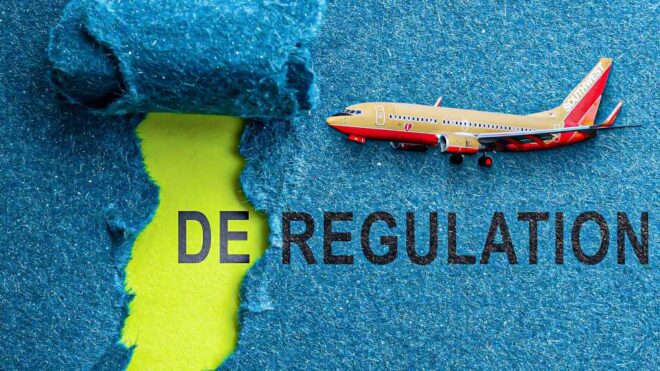
From its humble beginnings in the mid-1960s, Dallas-headquartered Southwest Airlines has grown to become one of the United States’ most prominent airlines. The game plan was to fly only within Texas and offer passengers lower fares than competing airlines like Braniff and Continental Airlines. The pair claimed that Air Southwest, as it was first called, used unfair business practices and filed lawsuits against their low-cost rival.
Air Southwest could offer passengers lower fares because flying only within Texas was exempt from federal Civil Aeronautics Board regulations. Braniff and Continental both claimed in their lawsuits that Southwest Airlines had an unfair advantage. The lawsuits were eventually settled in 1970, and by 1971, the newly named Southwest Airlines was offering low-cost fares on flights between the Golden Triangle of Texas cities of Dallas, Houston, and San Antonio.
The 1978 Airline Deregulation Act
In 1978, the United States Congress signed the Airline Deregulation Act, which effectively allowed airlines to fly whatever routes they wanted and to set the fares they wanted for tickets on those routes. Before the act, federal regulations had allowed airlines to prosper by keeping the cost of airfares high.
Because most of the established airlines were doing well, they opposed the changes and told their employees to lobby against any deregulation.
President Jimmy Carter appointed Cornell University economist Alfred E. Kahn to oversee the act. Kahn looked at the airline industry as strictly a business. He concluded that new legislation would be better for the industry as a whole as it would allow for the creation of new airlines that could offer fares lower than the established carriers.
How Southwest Airlines used the Airline Deregulation Act
For a low-cost carrier that only operated within Texas, the deregulation act was as if they had the goose that had laid the golden egg. Now free to fly anywhere they wanted without the risk of being sued and going to court, Southwest immediately looked to expand its footprint in the continental United States.
The timing of the Deregulation Act could not have come at a better time for Southwest Airlines as they had pretty much run out of destinations in Texas after adding Amarillo and Beaumont. Southwest Airlines first non-Texas route was between its home base at Dallas Love Field (DAL) and what is now Louis Armstrong New Orleans International Airport (MSY) in the neighboring state of Louisiana.
Ever since the Deregulation Act began being discussed, then CEO Larry Muse proposed Southwest Airlines opening an operations base at Chicago Midway International Airport (MDW). Located approximately 12 miles from the city’s loop business district, Muse knew it could become an essential hub for Southwest Airlines. Following the opening of Chicago O’Hare International Airport (ORD) in 1944, Midway began losing business as its short runways were not long enough to handle newer, bigger jets.
Southwest Airlines began flights from Midway in 1985
Despite Muse resigning from the board, he had sowed the seeds of a possible Midway base, and in 1985, Southwest Airlines began operating flights to and from Chicago. Today, Southwest Airlines is Midway’s biggest airline, handling 95% of all passenger traffic through the airport.
Already having a reputation for thinking outside the box, in the spring of 1995, Southwest Airlines unveiled its official website, “Southwest Airlines Home Gate,” and was immediately number one for online revenue.
Southwest Airlines buys AirTran
In 2010, Southwest Airlines purchased Orlando, Florida-based AirTran, gaining an entry point into Hartsfield–Jackson Atlanta International Airport (ATL) and additional valuable slots at New York LaGuardia Airport (LGA) and Ronald Reagan Washington National Airport (DCA).
Besides being able to get into Atlanta, the acquisition opened up new routes to Boston Logan International Airport (BOS) and several destinations in the Caribbean.
The Boeing 737 MAX and COVID-19
On August 29, 2017, Southwest Airlines took delivery of its first Boeing 737 MAX. As the plane’s launch customer, Southwest Airlines had invested heavily in new Boeing aircraft. At the time, Southwest Airlines and other operators of the Boeing 737 MAX had no idea that the plane had a flawed Maneuvering Characteristics Augmentation System (MCAS).
On March 13, 2019, the Federal Aviation Authority (FAA) grounded all Boeing 737 Aircraft following the crashes of Lion Air Flight 610 on October 29, 2018, and Ethiopian Airlines Flight 302 on March 10, 2019. At the time of the enforced grounding, the Boeing 737 MAX 8 made up around 5% of Southwest Airlines fleet. Not wanting to lose customers, Southwest Airlines told all passengers scheduled to fly on Boeing 737 MAX aircraft that they could rebook other Southwest Airlines flights without additional charges or fees.